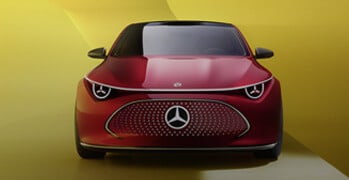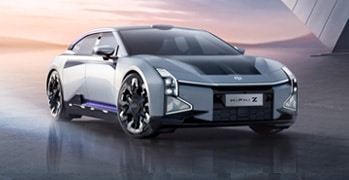

SPORTY, ELECTRIC, EMOTIVE: VOLKSWAGEN PRESENTS THE ID. GTI CONCEPT SHOW CAR
Wolfsburg. GTI – for decades now, this name has stood for compact sports cars from Volkswagen. Golf GTI, Scirocco GTi, Polo GTI, up! GTI. Volkswagen is now catapulting GTI DNA into the age of electric mobility with the new ID. GTI Concept.
The world premiere of this electrifying concept vehicle took place during this year’s IAA Mobility in Munich – exactly 48 years after the worldwide debut of the first Golf GTI at the IAA in Frankfurt. The ID. GTI Concept is based on the ID. all presented in March – a future electric compact car that costs around 25,000 euros and which has generated worldwide attention. Its front-wheel drive, clear design and powerful proportions make it the perfect starting point for a new GTI. Volkswagen Head of Design Andreas Mindt already also had the sporty derivative in mind when he produced the first sketches for the ID. all. And just like the ID. all, the ID. GTI Concept is more than just a show car – it is the first glimpse of the exciting GTI future because its series development has already been decided.
GTI Performance
Superior GTI power. There is a new, powerful GTI feeling in the way the first electric GTI unleashes its dynamic capabilities. This is because the maximum power and maximum torque are available with the lightning-fast speed typical of electric vehicles. The worlds of the electric ID. GTI Concept and turbocharged Golf GTI meetup when it comes to power transmission to the front axle. This is because a front-axle differential lock – electronically controlled by a Vehicle Dynamics Manager – is used just like in the current generation of the sports car icon. The Golf GTI and Golf GTI Clubsport were the first Volkswagen models with this traction control system. With the ID. GTI Concept, an electric Volkswagen now has this intelligent system on board for the first time. Following on from this, the letter "I" for injection in the GTI name now also stands for intelligence – in the form of high-performance drive and chassis intelligence.
With the ID. GTI Concept, Volkswagen is presenting a new evolutionary stage of these electronically networked driving dynamics systems. Here, the Vehicle Dynamics Manager of the ID.
GTI Concept integrates the powertrain into the control system to an even greater extent than on the petrol models. This is possible because the setup of the electric drive motor, as an electric system, can be varied almost infinitely. This permits realisation of a wide range of different GTI profiles. Using a newly developed GTI Experience Control on the centre console, the driver can choose which characteristics the powertrain of the ID. GTI Concept should have. For the first time, it is therefore possible to adjust the drive system, running gear, steering, sound experience and even the simulated shift points in the style of one of the historical GTI models.
GTI Exterior Design
GTI proportions. Like the original GTI, the ID. GTI Concept follows the principle of the design and technology of an affordable large-series model. And like with every previous GTI, this basis takes on the typical dynamic and customised features of the sporty icon. This transformation succeeds above all if the basic design of the product line already has GTI potential. This includes clear and powerful proportions and the visual stability of a body standing confidently on its wheels. The ID. all has this potential, which is why the ID. GTI Concept derived from it has dynamic characteristics that are otherwise found in completely different price classes.
In figures, this can be transferred to the ID. GTI Concept as follows: a compact 4,104 mm long, a large wheelbase of 2,600 mm, framed by large 20-inch alloy wheels with 245/35 performance tyres and accompanied by very short body overhangs. The GTI is 1,499 mm high and 1,840 mm wide. The two set up ID. GTI Concept vehicles are incidentally finished in Diamond Silver Metallic and Mars Red, both colours from the first-generation Golf GTI.
GTI radiator grille. At the front, the GTI concept vehicle has the most significant and well-known exterior feature of a GTI: the red surround of the radiator grille, which is almost completely closed in this case. The red line is narrow but nevertheless striking. At the front of the ID. GTI Concept, it spans the entire width of the concept vehicle below the IQ.LIGHT LED matrix headlights. The GTI logo in red letters is integrated in the line on the right. The headlights themselves are framed by a horizontal LED bar. A matrix module is incorporated in each headlight. The Volkswagen badge is illuminated in white.
GTI bumper. The design of the GTI bumper is inspired by motor sports and is unique to this model. It features a dominant black front splitter in the middle. Above this is the air intake with the honeycomb structure typical for a GTI (since the fifth generation). In the outer area of the grille there are two red towing eyes like those used in motor sports. At the sides, the designers have incorporated vertical LED daytime running lights in the black-framed air curtains of the front bumper. The air curtains route the air flow to the wheel housings and then outwards in a targeted manner in order to optimise the aerodynamic performance and cool the brakes. The low front splitter and vertical LED daytime running lights make the concept vehicle appear to hug the road. At the front, the future and past meet up once more because the matt-black area around the splitter and air intake evokes the low spoiler and bumper of the Golf GTI I – both were finished in matt black.
GTI silhouette. The C-pillar is the typical distinguishing feature of the ID. all side view and is also a defining element of the ID. GTI Concept silhouette. The visual stability of the C-pillar flows into the side of the body to create a powerful appearance.
A second stabilising Volkswagen element is the straight window shoulder – the side contour between the A- and C-pillars. In combination with the feature line running parallel below this and the muscular side sills, this creates a positive tension in the surfaces that is typical for a Volkswagen and for a GTI. In addition, the side sills are covered at the bottom with matt-black plastic elements which optimise the vehicle aerodynamically and make it appear sportily low-slung on the road in combination with the large wheels.


GTI wheel rims. The flared wheel housing extensions in matt black are another GTI feature. The 20-inch GTI Concept alloy wheels were designed specifically for the concept vehicle. They have eight double spokes and a striking circle of eight openings; the inner surfaces of the wheel rims are black, while the edges of the eight openings have a high-gloss polished finish. Distinctive wheel designs – such as the legendary Pirelli wheel rim from the Golf GTI I and the Denver wheel rim from the Golf GTI V – are traditionally among the characteristic features of a GTI.
GTI roof spoiler. The designers of the first Golf created an unmistakeable GTI rear end 47 years ago without modifying the body panels. At the same time, they created typical GTI features. These included the rear window with black surround and the always black instead of chrome-plated bumper. With the ID. GTI Concept, the Volkswagen design team has now reinterpreted these features. A black roof spoiler is now used instead of a black rear window frame and is flanked by black air guide elements at the sides. Like on the current Golf GTI Clubsport, the large spoiler is open in the roof transition, apart from a small rib in the centre. The spoiler ensures optimum downforce and minimum air turbulence. Under the spoiler, a narrow LED strip runs across the entire width of the vehicle as a third brake light.
The GTI tail light clusters and rear diffuser. Whereas the ID. all concept vehicle is equipped with a horizontal LED tail light cluster bar in red, this element has a dark tint on the GTI model. Only the frames of the two 3D tail light clusters located on the left and right and the Volkswagen badge illuminate in bright red. A blackshaded area below the horizontal tail light cluster bar picks up on the theme of the black bumper of the Golf GTI. The GTI lettering is integrated in the middle of this area. The two-part rear diffuser is also black and has a powerful design. This aerodynamic element is flanked at the sides by the wheel housing extensions and extends to the rear beyond the body, thus protecting the painted bumper surfaces. In this way, the diffuser also evokes the black bumper of the first Golf GTI.


GTI Interior-Concept
Original GTI shapes the ID. GTI Concept. The first GTI already generated excitement in 1976 with its specific interior design. Back then, sports seats with a chequer pattern, a three-spoke steering wheel with a low impact absorber (which fans lovingly called a ‘spittoon’) and a gear knob in the design of a golf ball were the things that turned a Golf into a GTI. This also works in a similar form in 2023 – but in a completely different and fascinating way.
GTI steering wheel with 12 o’clock marker and GTI Experience Control in golf ball design. The three-spoke steering wheel of the ID. GTI Concept is equipped with an airbag that is located slightly lower down to create a visual bridge to the impact absorber in the Golf GTI I. The illuminated 12 o’clock marker always shows the driver the way. The two horizontal spokes of the multifunction steering wheel each accommodate an easy-grip thumbwheel and two buttons. Among other things, the driver uses these to control the individually configurable digital instruments, the augmented reality head-up display and functions such as audio volume. Since the automatic gearbox is operated by means of a steering column switch, as in the ID.77, the interior designers have transferred the golf ball design of the first GTI gear knob to the multifunction GTI Experience Control in the centre console. The latter is used to control the different driving profiles and the individual looks.
GTI cockpit. Digital displays inside the concept vehicle allow new designs and functions, making it possible to experience the GTI idea in more varied ways than before.
Fundamentally different cockpit looks are available for the instruments of the ID. GTI Concept: the basic configuration is a reflection of the current digital age – with all conceivable information and functions and a sporty GTI graphic design. In the Vintage mode, the GTI Digital Cockpit (27.7 cm / 10.9 inches) in front of the driver is transformed into the instruments of a Golf GTI I from the second series, for example, just like the instruments that were also used in the legendary Pirelli GTI – and a perfect match for the Golf GTI I mode that can be activated with the GTI Experience Control.


GTI head-up display and GTI mode. The designers and engineers have also taken a new approach with the augmented reality head-up display. It projects a new data spectrum on to the windscreen – and now not just for the driver but also for the front passenger. This means the virtual and real worlds are merged for the ‘co-driver’ as well on board the concept vehicle. In standard driving mode, information such as the speed or current range is projected in front of the driver and front passenger. In this basic configuration, the white colour GTI Silver Drive is used for the background lighting and displays.
As soon as the driver activates the new GTI mode with a special GTI button on the multifunction steering wheel, the background lighting and all displays switch to the colour GTI Red Turbo. The background: as a powerful, compact sports car with a low centre of gravity (battery in the vehicle floor) and a low weight for an electric vehicle, the ID. GTI Concept is perfect for driving on race tracks. If the driver goes on to the legendary Nürburgring Nordschleife in GTI mode, for example, they can display the course of the track and the position of the ID. GTI Concept on the far left of the windscreen. When driving in a race, the driver can additionally see their current position in the field and their progress (‘GTI Achievements’). Among other things, the front passenger can see the current lap times of laps that have already been completed. The concept vehicle thus becomes a projection of tomorrow’s world and shows by way of example what could and will be possible.
GTI infotainment and interfaces. The touch display (diagonal: 32.7 cm / 12.9 inches) of the infotainment system is already a near-production version with its intuitive graphics and menu structure. The same applies to the air-conditioning block located under the display. The main air-conditioning functions are controlled here using illuminated buttons. In the middle of the air conditioning block – easily accessible for both driver and front passenger – there is a practical small thumbwheel to adjust the volume of the infotainment system. Located a level further down are two large inductive charging interfaces for smartphones, which are magnetically locked in position.
As described above, other vehicle functions are controlled using the GTI Experience Control integrated in the centre console. Numerous USBC interfaces (45 W) distributed throughout the vehicle interior supply power to smartphones.All conceivable larger devices can be powered by a fully usable 230 V socket.


GTI seat with GTI heartbeat. Sports seats were a characteristic feature of the first Golf GTI and the ergonomically designed seats also catch the eye in the new ID. GTI Concept. Their inner surfaces naturally have a reinterpreted GTI chequer pattern. The fabric is called Jack-e (instead of Jacky, the name used for the fabric in the Golf GTI VI). The driver seat backrest is additionally equipped with a pulse sensor (GTI Heartbeat) – a red-pulsating LED element. When the concept vehicle is locked using the remote control, this activates the antitheft alarm and the GTI Heartbeat visible from outside and signals to the driver that the vehicle is secure.
GTI everyday usability. The interior of the ID. GTI Concept is characterised by clear design, high quality and intuitive operation. The four-door vehicle can accommodate five passengers. The luggage compartment is also generous with a capacity of 490 litres. What’s more, since the ID. GTI Concept shares the MEB entry package with the ID. all, it also has the same practical details. These include features such as an additional stowage box under that double luggage compartment floor, which can accommodate several bags of shopping, for example. There is a further 50-litre stowage area under the rear bench seat, which can be folded up in one easy movement. This stowage area was specially designed for the charging cable and items such as the first-aid kit, high visibility waistcoats and breakdown set. In addition, there is enough space in this lockable (safe) compartment for devices such as laptops and tablets, which can also be charged there. When the rear bench seat with 60:40 split is folded down, the luggage compartment capacity increases to 1,330 litres.
The ID. GTI Concept is not just at home when driving short distances and on the race track, but is also equally suitable for long journeys. This is ensured by its efficient drive system, the low weight, good aerodynamics, comfortable running gear in spite of the vehicle’s sportiness, and a large battery.



















